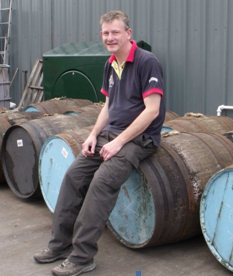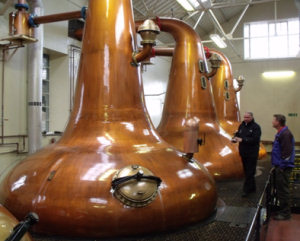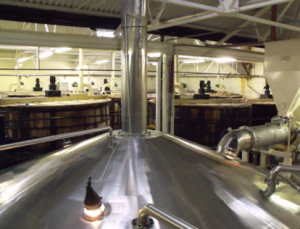 |
 |
|

|
|

|
 |
home
about
Protz
features
A-Z
books
|
|
Protz:
features
reviews
tastings
news & events
books
|

| |
the beers of Harviestoun
by Willard Clarke, 12/10
Distance is no object in the brewing industry. The impressive brewing kit at Harviestoun in Scotland started life as a pilot plant in St Austell in deepest Cornwall, but now it's producing 10,000 barrels a
year in Alva, near Alloa.
Harviestoun is another exhilarating example of the success of cask beer producers. The brewery started life with a five-barrel plant in a barn on a farm in Dollar in 1985 but has moved to a custom-built site
on an industrial estate. "Industrial estate" conjures up an image of slightly ramshackle buildings surrounded by skips, but Alva has attractive whitewashed offices and warehouses at the foot of the
densely-wooded Ochil hills.
The Scottish pub scene is different to England. There's little official tied trade. In the American and French style, big brewers operate on the basis of loans and discounts to dominate the supply of beer.
While there are now dozens of craft beer brewers in Scotland, many of them look to England to sell the bulk of their products.
This is true of Harviestoun. Chris Miller and his team distribute beer by direct delivery within a 50-mile radius but most of their cask beer production - and production is split 50:50 between cask and bottle -
goes over the border. The brewery is best known for its Bitter & Twisted golden ale and cask lager Schiehallion, both of which have won awards in the Champion Beer of Britain competition: B&T was named
overall champion beer in 2003, which gave both the brand and the company great presence throughout the whole of the UK.
 Head brewer Stuart Cail (pictured with casks of Ola Dubh), who worked for Vaux, Daleside and Butcombe before moving to Scotland, showed me round his spacious brewhouse, where he has plenty of room for expansion. A new fermenting vessel is on order to keep up with the increasing demand for the beers. The brewery was for some years a subsidiary of Caledonian Brewery in Edinburgh but when "Caley" became first part of Scottish & Newcastle and then Heineken, Harviestoun opted to return to independent status, swapping the clog for the claymore.
The most fascinating beer at Harviestoun in called Ola Dubh. It means Black Oil in Gaelic and is a stronger version of the brewery's acclaimed porter-style beer Old Engine Oil, with a rich chocolate, coffee and burnt fruit character balanced by powerful hop notes. Encouraged by the success of Innis & Gunn in Edinburgh, where beer is matured in American oak casks obtained from the bourbon industry, Chris Miller and Stuart Cail spoke to the managers of the Highland Park distillery on Orkney about the possibility of using whisky casks to mature Ola Dubh.
Head brewer Stuart Cail (pictured with casks of Ola Dubh), who worked for Vaux, Daleside and Butcombe before moving to Scotland, showed me round his spacious brewhouse, where he has plenty of room for expansion. A new fermenting vessel is on order to keep up with the increasing demand for the beers. The brewery was for some years a subsidiary of Caledonian Brewery in Edinburgh but when "Caley" became first part of Scottish & Newcastle and then Heineken, Harviestoun opted to return to independent status, swapping the clog for the claymore.
The most fascinating beer at Harviestoun in called Ola Dubh. It means Black Oil in Gaelic and is a stronger version of the brewery's acclaimed porter-style beer Old Engine Oil, with a rich chocolate, coffee and burnt fruit character balanced by powerful hop notes. Encouraged by the success of Innis & Gunn in Edinburgh, where beer is matured in American oak casks obtained from the bourbon industry, Chris Miller and Stuart Cail spoke to the managers of the Highland Park distillery on Orkney about the possibility of using whisky casks to mature Ola Dubh.
 Miller and Cail wanted a beer that was distinctly different to Innis & Gunn. They chose Highland Park as a result of its reputation as one of the finest producers of single malt Scotch whisky and the fact that it uses not bourbon casks but ones obtained from the Spanish sherry industry. The distillery's casks are first used to make Oloroso, a rich, dark sherry that infuses the wood with superb fruity notes.
Following the brewery tour, Stuart Cail and I made the short plane hop to Orkney where we toured Highland Park. The distillery is breathtaking. Founded in 1798, it's based in a series of stone buildings that include
a maltings where Optic barley is turned into malt and dried and gently roasted in a kiln fired by peat and coke. Brewing and distilling are remarkably similar. At Highland Park, the malt is mixed in a mash tun
with pure hot water to produce a sweet extract called wort. Above: Stuart Cail discusses the stills at Highland Park.
Miller and Cail wanted a beer that was distinctly different to Innis & Gunn. They chose Highland Park as a result of its reputation as one of the finest producers of single malt Scotch whisky and the fact that it uses not bourbon casks but ones obtained from the Spanish sherry industry. The distillery's casks are first used to make Oloroso, a rich, dark sherry that infuses the wood with superb fruity notes.
Following the brewery tour, Stuart Cail and I made the short plane hop to Orkney where we toured Highland Park. The distillery is breathtaking. Founded in 1798, it's based in a series of stone buildings that include
a maltings where Optic barley is turned into malt and dried and gently roasted in a kiln fired by peat and coke. Brewing and distilling are remarkably similar. At Highland Park, the malt is mixed in a mash tun
with pure hot water to produce a sweet extract called wort. Above: Stuart Cail discusses the stills at Highland Park.
 The major difference between brewing and distilling is that no hops are used in whisky production. The wort is transferred to wooden fermenting vessels called wash backs, where yeast is added. Fermentation lasts
for 100 hours and the liquid - strictly speaking ale without hops - goes to the still room. Right: mash tuns and wash backs at Highland Park.
The stills represent the highpoint of the tour, four tall burnished copper vessels in a cool, tiled room where the beer is heated, condensed and distilled twice, with only the finest spirit - the middle cut - used for whisky. The liquid created, as pale as gin or vodka, is then run into casks that cost between �400 and �600 each, four times the price of bourbon casks. The casks are stored three deep in 19 warehouses and are left to ripen, picking up flavour and colour from the sherry that has impregnated the wood.
Highland Park produces 12, 18, 25, 30 and 40 year old versions known as expressions. It was a joy and a revelation to sample them all and to note how aged developed the citrus, honey, spice, peat, vanilla and smoke character of the whiskies.
These characteristics are also evident in the five 8% expressions of Ola Dubh, where the sherry/fruit, vanilla/oak character of the wood infuses and blends with the roasted grain, burnt fruit, chocolate and bitter hops of the beer.
Sampling both beer and whisky was a journey into Scotland's Highland and island past where out of the mists of history came a drink called uisge beatha, the water of life, that now
beguiles us as both malt whisky and beer matured in wood. Sláinte!
The major difference between brewing and distilling is that no hops are used in whisky production. The wort is transferred to wooden fermenting vessels called wash backs, where yeast is added. Fermentation lasts
for 100 hours and the liquid - strictly speaking ale without hops - goes to the still room. Right: mash tuns and wash backs at Highland Park.
The stills represent the highpoint of the tour, four tall burnished copper vessels in a cool, tiled room where the beer is heated, condensed and distilled twice, with only the finest spirit - the middle cut - used for whisky. The liquid created, as pale as gin or vodka, is then run into casks that cost between �400 and �600 each, four times the price of bourbon casks. The casks are stored three deep in 19 warehouses and are left to ripen, picking up flavour and colour from the sherry that has impregnated the wood.
Highland Park produces 12, 18, 25, 30 and 40 year old versions known as expressions. It was a joy and a revelation to sample them all and to note how aged developed the citrus, honey, spice, peat, vanilla and smoke character of the whiskies.
These characteristics are also evident in the five 8% expressions of Ola Dubh, where the sherry/fruit, vanilla/oak character of the wood infuses and blends with the roasted grain, burnt fruit, chocolate and bitter hops of the beer.
Sampling both beer and whisky was a journey into Scotland's Highland and island past where out of the mists of history came a drink called uisge beatha, the water of life, that now
beguiles us as both malt whisky and beer matured in wood. Sláinte!
|
|
home
about
Protz
features
A-Z
books
|